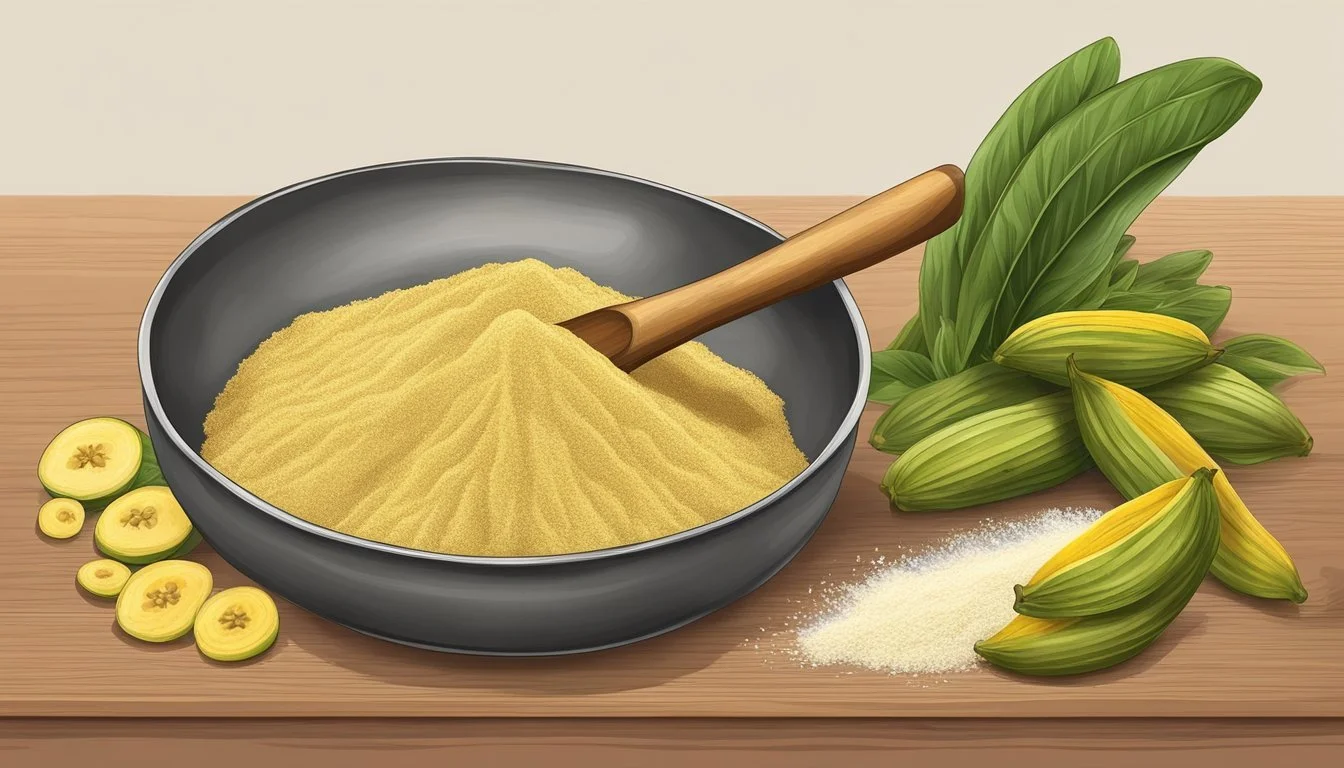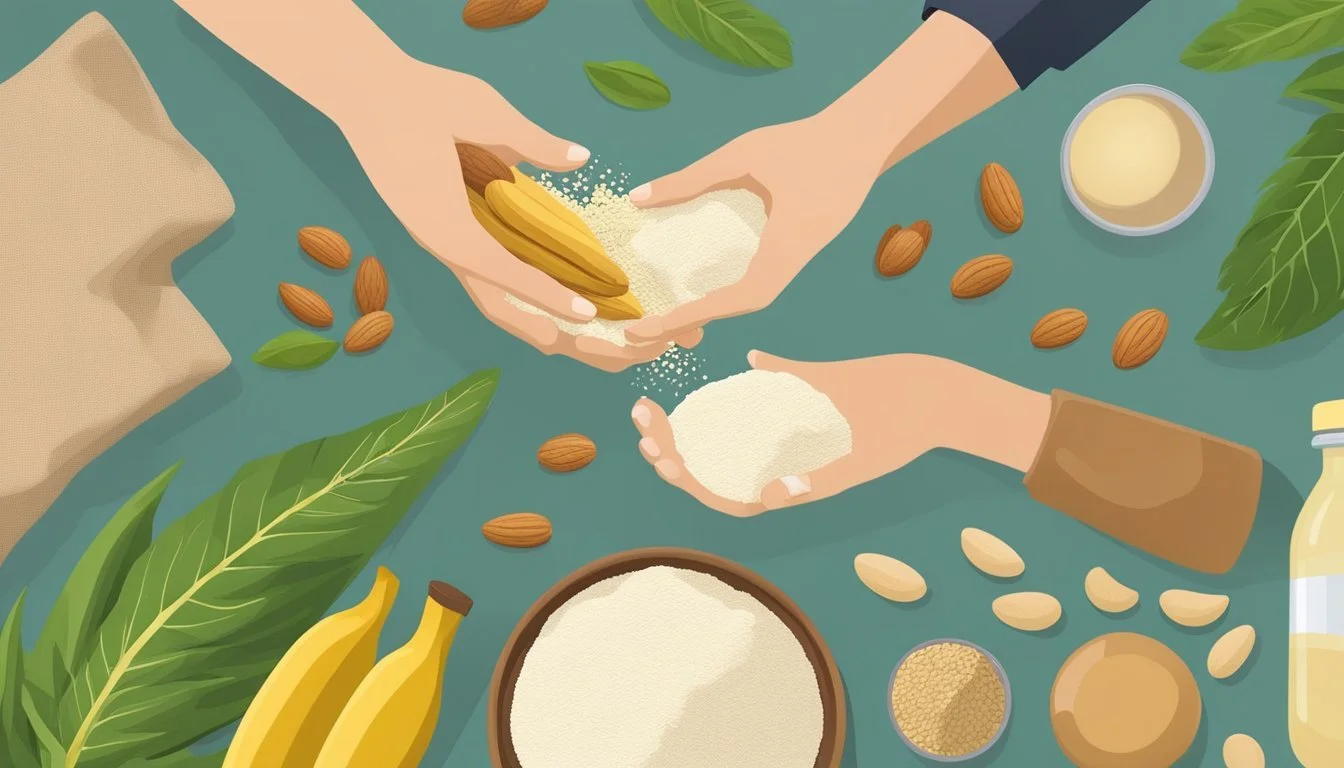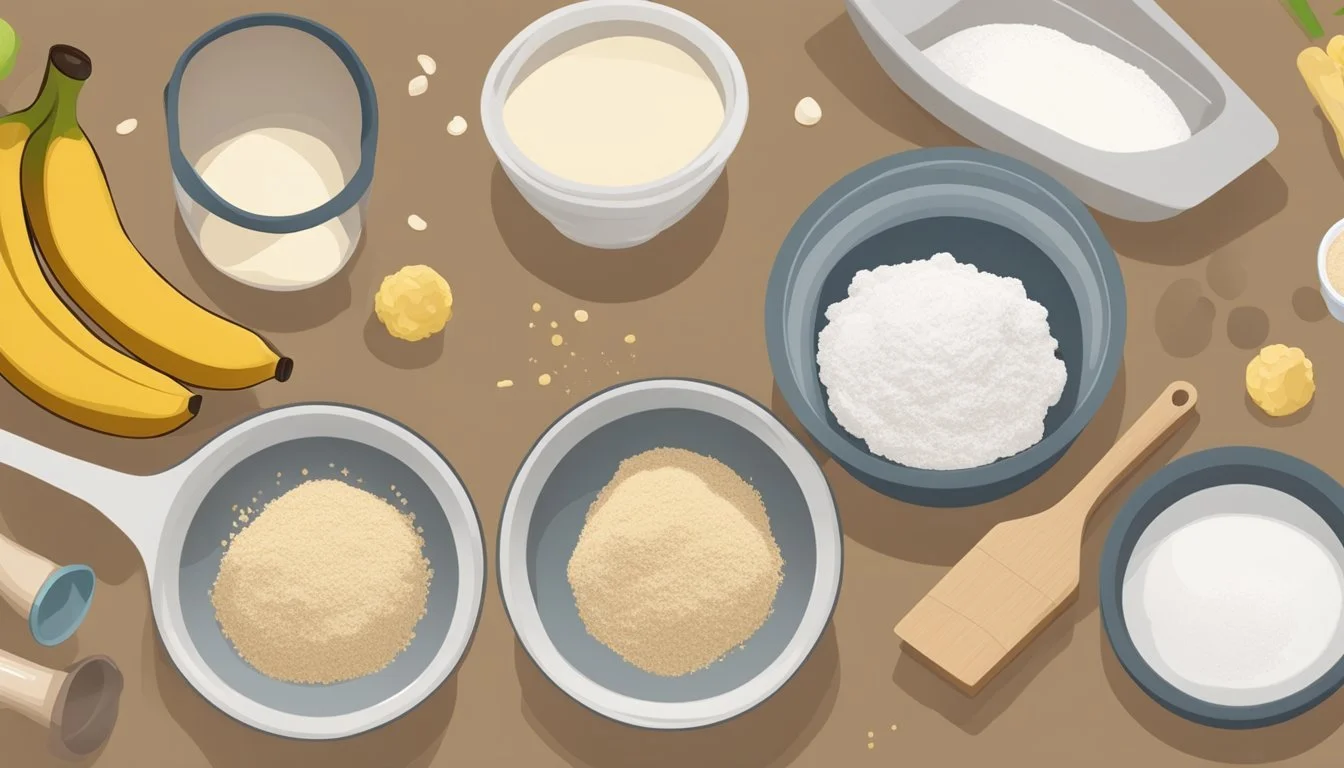Plantain Flour Substitutes
Top Alternatives for Gluten-Free Cooking
When it comes to gluten-free baking, plantain flour stands out for its versatility and nutritional benefits. However, plantain flour may not always be readily available or affordable. For those occasions, several substitutes work exceptionally well in various recipes, including unripe bananas, yuca roots, and sweet potatoes. Each of these alternatives can mimic the characteristics of plantain flour, ensuring that your baking projects don't have to miss a beat.
Unripe bananas are arguably the closest substitute to plantain flour, providing a similar texture and taste. They work particularly well in recipes that require a neutral flavor and sturdy texture. Yuca root is another excellent option, offering a dense and starchy alternative that performs admirably in baked goods. Sweet potatoes, with their natural sweetness and moisture, can also replace plantain flour, particularly in recipes that benefit from a bit more moisture.
Whether you're making tortillas, pancakes, or even biscuits, these plantain flour substitutes can ensure you maintain a healthy, gluten-free diet without compromising on texture or flavor. The key to successful substitution lies in understanding the specific needs of your recipe and choosing the best alternative ingredient accordingly.
Understanding Plantain Flour
Plantain flour is a versatile and nutritious alternative to traditional wheat flour. This section elaborates on its origins, nutritional content, texture, flavor, and culinary uses.
Origins and Usage
Plantain flour is derived from green, unripe plantains, a type of banana that is longer and less sweet than common yellow bananas. The process involves peeling, slicing, drying, and grinding the plantains into a fine powder. This flour is popular in many tropical regions where plantains are a staple food.
Its gluten-free nature makes it ideal for those with celiac disease or gluten intolerance. It is also suitable for lactose-free, egg-free, and paleo diets. Plantain flour can replace a portion of wheat flour in recipes, enhancing the nutritional value of baked goods.
Nutritional Profile
Plantain flour is rich in essential nutrients. It contains high levels of fiber, potassium, and vitamin C. The fiber content aids in digestion and helps maintain regular bowel movements. Potassium is crucial for maintaining electrolyte balance and heart health.
Vitamin C in plantain flour acts as an antioxidant, assisting in boosting the immune system and protecting the body against free radical damage. Additionally, plantain flour is low in fat and contains small amounts of protein, making it a healthy alternative to wheat flour.
Texture and Flavor Characteristics
The texture of plantain flour is similar to that of green banana flour—it is smooth and fine when milled properly. This makes it suitable for a variety of baked goods. The flour retains a starchy quality, which helps in binding ingredients together without the need for gluten.
In terms of flavor, plantain flour has a mild, slightly earthy taste. Unlike the sweet taste of ripe bananas, plantains in the unripe stage contribute a more neutral flavor that can blend well with both savory and sweet dishes. This makes it particularly versatile in the kitchen.
Culinary Applications
Plantain flour can be used in a wide range of culinary applications. It is particularly popular in baking recipes, such as bread, pancakes, and biscuits. When replacing wheat flour, it is often recommended to substitute up to 30% with plantain flour to balance texture and flavor.
In addition to baked goods, plantain flour can be used as a thickening agent in soups, stews, and sauces. It can also be used to make plantain chips by slicing plantains and coating them in the flour before frying or baking. The versatility of this flour makes it a valuable addition to many recipes that benefit from its starchy and mildly flavored profile.
Health Considerations of Plantain Flour
Plantain flour offers various health benefits and can be an excellent substitute for traditional flours. It is suitable for those with specific dietary needs and does not contain gluten, making it friendly for various diets.
Allergies and Sensitivities
Plantain flour is naturally gluten-free, which makes it a safe alternative for individuals with celiac disease or gluten sensitivity. Unlike all-purpose flour, it does not trigger allergic reactions in people who cannot tolerate gluten.
Since plantains are a type of fruit, allergies to them are rare but possible. Symptoms can include itching, swelling, or digestive discomfort. It is advisable to consult a healthcare provider before incorporating plantain flour into the diet if there’s a history of allergies to similar foods.
Dietary Benefits
One of the primary benefits of plantain flour is its high fiber content. The dietary fiber in plantain flour aids in digestion and helps maintain healthy bowel movements. It can be particularly beneficial for those seeking to improve their digestive health.
Plantain flour also contains resistant starch, which acts like dietary fiber in the body. Resistant starch does not get digested in the small intestine, and instead, it ferments in the colon. This process helps maintain a healthy gut microbiome and can contribute to a feeling of fullness, aiding in weight management.
Plantain Flour in Special Diets
Plantain flour fits well into various special diets. For example, it is compatible with the paleo diet since it is a non-grain flour. It can also be used in vegan recipes as a substitute for all-purpose flour, providing a nutrient-dense alternative.
Individuals on a gluten-free diet will find plantain flour an excellent option as it naturally lacks gluten. It can be used in combination with other gluten-free flours like almond flour or buckwheat flour to create diverse baked goods. Plantain flour is also beneficial for those looking to reduce carbohydrate intake due to its resistant starch content, which has a lower impact on blood sugar levels.
Common Plantain Flour Substitutes
When plantain flour is unavailable, there are several viable alternatives, each offering unique properties that may suit different dietary and culinary needs. Below are five common substitutes with their characteristics and uses.
Banana Flour
Banana flour is a natural and nutritious alternative to plantain flour. Made from green bananas, it shares a similar texture and flavor profile. It is gluten-free and rich in resistant starch, which is beneficial for digestive health. It works well in baking and can be used to thicken soups and sauces.
It has a neutral taste, making it versatile in both sweet and savory dishes. For those with gluten sensitivities, banana flour is an excellent choice. It can be used in equal measure as a one-to-one substitute for plantain flour in most recipes.
Green Banana Flour
Green banana flour is made from unripe bananas and is closer to plantain flour than regular banana flour in both texture and taste. It is also gluten-free and high in fiber. Its resistant starch content aids in gut health and glycemic control.
Green banana flour is particularly useful for those with celiac disease or gluten intolerance. It is often used in baking, pancakes, and as a thickening agent in various recipes. Its subtle flavor allows it to blend seamlessly into both sweet and savory dishes.
Coconut Flour
Coconut flour is another popular gluten-free substitute for plantain flour. Made from dried coconut meat, it has a distinct coconut flavor and aroma. It is rich in fiber, protein, and healthy fats, making it a nutritious addition to various recipes.
Coconut flour is highly absorbent, so it requires more liquid in recipes compared to plantain flour. When substituting, use about one-fourth of the amount specified for plantain flour and increase the liquid content. It is ideal for baking and adding a tropical twist to your dishes.
Cassava Flour
Cassava flour is derived from the root of the cassava plant. It has a neutral flavor and smooth texture, making it a versatile substitute for plantain flour. It is gluten-free and often used in Paleo and grain-free diets.
Cassava flour can be used in a 1:1 ratio substitution for plantain flour in most recipes. It is suitable for baking, thickening sauces, and making tortillas. Its mild flavor profile makes it a good choice for those who want a less noticeable change in taste.
Chickpea Flour
Chickpea flour, also known as garbanzo bean flour, offers a high-protein, gluten-free alternative to plantain flour. It has a somewhat nutty flavor and works well in savory dishes.
This flour is versatile in its use, from baking to making pancakes and even as a binding agent in cooking. When substituting, start with a slightly smaller amount than plantain flour and adjust liquid quantities accordingly. Its unique flavor and high nutritional value make it a valuable substitute in many recipes.
Selecting the Right Substitute for Your Recipe
Choosing the appropriate substitute for plantain flour depends on the specific requirements of your recipe, including whether it is sweet or savory, the desired texture, and how to balance taste and sweetness.
Sweet vs. Savory Dishes
When selecting a flour substitute, consider the type of dish you are preparing. For sweet dishes, almond flour is a great option, providing a slightly nutty flavor that complements cookies and cakes. Coconut flour is another choice, known for its subtle sweetness and moisture-absorbing properties.
For savory dishes, chickpea flour works well due to its dense texture and protein-rich content. Likewise, amaranth flour is suitable for savory pancakes. It's important to match the substitute to enhance rather than overpower the dish.
Texture Considerations
The texture of the flour substitute significantly impacts the final product. Almond flour creates a moist and dense texture, which is suitable for brownies and muffins. Conversely, coconut flour can make baked goods airy and light but requires more liquid due to its absorbent nature.
Chickpea flour offers a grainy texture that pairs well with flatbreads and coatings for fried foods. Amaranth flour provides a slightly chewy texture, making it ideal for dense baked items. Pay attention to these characteristics to maintain the desired consistency of your recipe.
Adjusting for Taste and Sweetness
The taste and sweetness of the substitute can alter the overall flavor profile. Almond flour adds a nuttiness which enhances sweets and pastries. Coconut flour imparts a mild, natural sweetness.
If using chickpea flour, expect a pronounced earthy flavor that works best in savory contexts. Amaranth flour has a slightly peppery taste, which can complement robust flavors in savory dishes. Adjust the amount of sugar or spices in your recipe accordingly to balance these distinct tastes.
By considering the above factors—sweet vs. savory, texture, and taste—you can effectively select a substitute that complements your dish and maintains the integrity of your recipe.
How to Use Plantain Flour Substitutes in Baking
When using plantain flour substitutes, attention to measurement and consistency, combining with other flours, and adjusting baking times and temperatures is crucial for achieving the desired baking results.
Measurement and Consistency
Accurate measurement of plantain flour substitutes is key. Unlike traditional flour, substitutes like yuca roots, yams, or unripe bananas may vary in absorbency and density.
Use a kitchen scale to get precise measurements:
Traditional all-purpose flour: 120-125 grams per cup.
Plantain substitutes should be spooned into the bowl and leveled off to ensure consistency.
This is particularly important for achieving the correct texture in recipes like tortillas or flatbreads.
Mixing with Other Flours
To reach the desired consistency, it often helps to blend plantain flour substitutes with other flours. For instance, combining plantain with tapioca starch or coconut flour can balance moisture and density.
Blend ratios might include:
50% plantain flour with 50% tapioca starch for a balanced consistency.
Use a mix of plantain flour and all-purpose flour if gluten is not a concern.
Mix thoroughly to avoid lumps, especially when baking items like plantain chips.
Modifying Baking Times and Temperatures
Plantain flour substitutes can affect baking times and temperatures. They may require lower oven temperatures and longer baking times due to their absorbency and heavier consistency.
Baking adjustments include:
Reduce oven temperature by 25°F compared to recipes using traditional flour.
Increase baking time by 10-15 minutes, especially for dense baked goods like bread.
Keep an eye on the moisture levels; overbaked goods can become dry. Baking items like plantain tortillas might need a shorter cooking time to stay pliable and moist. Adjusting these variables ensures the end product is neither too dry nor undercooked.
Grain-Free and Gluten-Free Alternatives
Exploring grain-free and gluten-free flours can provide diverse options for those with dietary restrictions. Here, we focus on almond flour, paleo-friendly options, and keto diet choices, highlighting their unique properties and uses.
Almond Flour
Almond flour is a popular choice for those avoiding grains and gluten. Made by grinding blanched almonds, it has a slightly sweet flavor and moist texture, making it ideal for baked goods.
Almond flour is rich in protein, healthy fats, and vitamin E. It's excellent for recipes like cakes, cookies, and pancakes, providing a moist and tender crumb. Its low carbohydrate content makes it suitable for keto diets as well.
Use almond flour as a 1:1 substitute for regular flour in most recipes, but note that it absorbs liquids differently. Therefore, adjusting other ingredients, like eggs or binding agents, may be necessary.
Paleo-Friendly Options
Cassava flour and coconut flour are key players in the paleo diet. Cassava flour, derived from the yuca root, mimics the texture and consistency of wheat flour, making it a versatile option for various recipes.
Coconut flour is made from dried coconut meat. It has a high fiber content and absorbs a significant amount of liquid, which means recipes usually require more eggs or liquid than other flours.
Both options are not only grain-free but also gluten-free. They cater well to those seeking natural, unprocessed ingredients and are compatible with paleo baking recipes for bread, pancakes, and more.
Keto Diet Choices
Besides almond flour, flaxseed meal and chia flour are excellent keto-friendly alternatives. Flaxseed meal, derived from ground flax seeds, is high in omega-3 fatty acids and fiber, contributing to better digestion and heart health.
Chia flour, made from ground chia seeds, also boasts high fiber and protein content. Both can be used as binding agents, reducing the need for gluten or other binders. These flours work especially well in baking recipes like muffins and bread.
Flaxseed and chia flours can often replace some of the flour in keto recipes, providing a nutritional boost while keeping carb counts low. Use them in combination with almond flour for best results in keto-friendly baking.
Incorporating Substitutes into International Cuisines
Substituting plantain flour with various alternatives provides unique adaptations across diverse culinary traditions. Exploring how these substitutes interact with traditional recipes can expand gastronomic horizons.
African Cuisine Adaptations
In African cuisine, substitutes like yuca root and sweet potatoes are commonly used. Yuca root, with its starchy texture, is often used in fufu, a staple in many West African dining experiences. The inclusion of sweet potatoes can be found in dishes such as pounded yam. Sweet potatoes add both nutrition and a subtly sweet flavor. Mixing these ingredients with cassava or yam flour creates dishes that preserve tradition while introducing new flavors.
Caribbean Recipe Variations
Caribbean cuisine frequently incorporates breadfruit and jackfruit as alternatives to plantain flour. Breadfruit, rich in carbohydrates, is used for making plantain bread or fried chips. Jackfruit, known for its versatile texture, appears in savory dishes such as curries and stews. These substitutions help preserve the island's vibrant culinary culture while catering to dietary needs. For desserts, green bananas can replace plantains in baked goods.
South Asian Culinary Uses
South Asian dishes benefit from using substitutes like unripe bananas and yams. Unripe bananas are used in Kerala's traditional banana chips and are an excellent alternative for plantains. Yams, with their dense texture, find their way into curries and fritters. Incorporating these substitutes helps maintain the region's rich culinary diversity. For gluten-free baking, green plantain flour is swapped with these alternatives to create flavorful and nutritious options.
By embracing these alternatives, each cuisine can maintain its cultural integrity while adapting to the availability and dietary needs of modern times.
Additional Considerations
When looking at substitutes for plantain flour, it's important to consider various factors such as cost, accessibility, shelf life, storage options, and environmental impact. Each of these factors can influence your choice significantly.
Cost and Accessibility
Budget-friendly options may include unripe bananas and sweet potatoes, which are generally cheaper and more widely available. Alternatives like green banana flour might be pricier depending on your location.
Plantain flour and its substitutes, such as yuca roots and jackfruits, vary in cost based on regional availability and seasonality. Making homemade flour from these substitutes can often be more cost-effective than purchasing pre-made options.
Shelf Life and Storage
Plantain flour and its alternatives have different shelf lives. For instance, sweet potato and banana flour typically have a longer shelf life when stored properly.
Keep unripe bananas in a cool, dry place to extend their usability as a substitute.
Yuca roots need refrigeration and should be used within a few weeks.
Properly storing substitutes in airtight containers can prevent moisture absorption and prolong shelf life.
Environmental Impact
Environmental considerations should also play a role in choosing plantain flour substitutes. Substitutes like yams, breadfruits, and jackfruits generally have a lower environmental impact due to their easy-to-grow nature and minimal need for pesticides.
Local sourcing of substitutes not only supports sustainable agriculture but also reduces the carbon footprint associated with transportation.
Growing and harvesting regional produce can be more eco-friendly and offer better nutritional content for specific dietary needs.
These additional considerations can significantly influence your choice of plantain flour substitutes, helping you make informed decisions that cater to both your budget and dietary requirements while being mindful of environmental factors.








